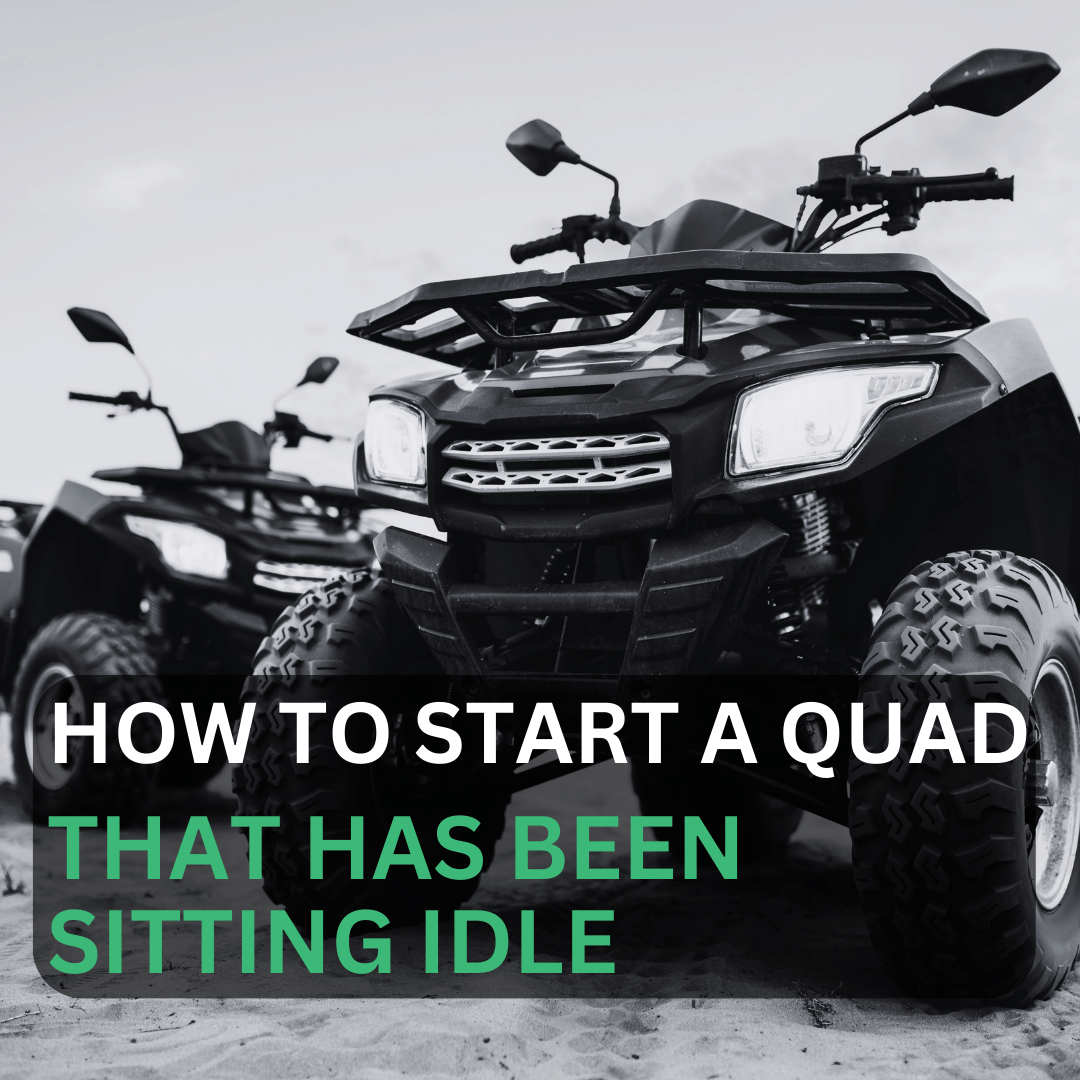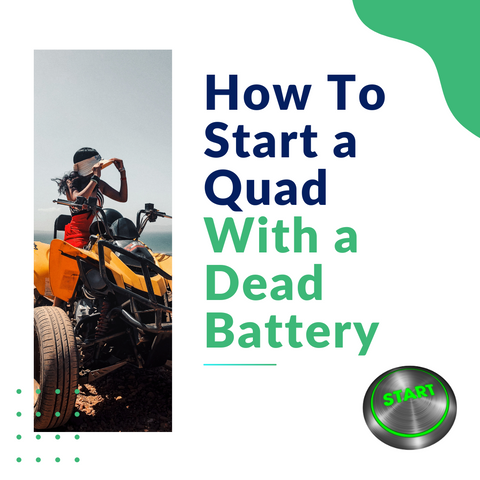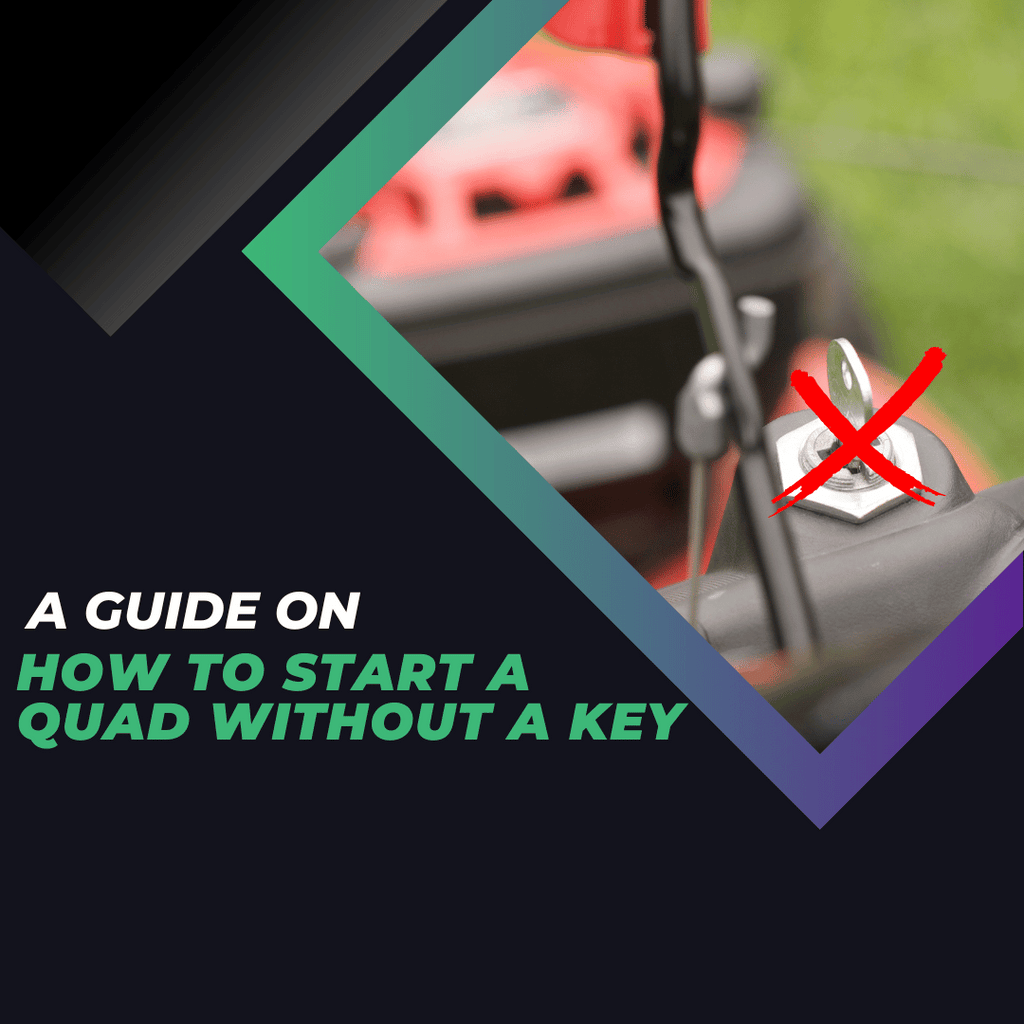Published: 12.7.23
Updated: 22.7.24
Faced with the task of reinvigorating a quad bike that's been sitting idle?You're not alone.
It's an all too familiar scenario for many quad owners. Luckily, you've found the perfect guide.
We're here to walk you through the process, step by step, of restoring your dormant quad to its former glory.
Step 1: Understanding Your Quad
The Importance of Regular Maintenance
Quads, just like any other vehicle, need regular attention to keep them in peak condition.
Without it, they're susceptible to all kinds of issues, from fuel system clogs to battery drain.
Maintenance keeps these problems at bay.
Potential Problems When Sitting Idle
If a quad sits idle for a long period, it faces a risk of myriad problems.
These range from stale fuel and clogged carburettors to dead batteries. However, with the right care and process, these issues can be sorted out.
These range from stale fuel and clogged carburetors to dead batteries. However, with the right care and process, these issues can be sorted out.
Step 2: The Preparation Process
Draining the Fuel Tank
When fuel sits for a long time, it can become stale, and stale fuel doesn't burn efficiently.
Hence, it's vital to drain the old fuel. Turn off the fuel intake valve and drain the fuel tank completely.
Cleaning the Carburetor
Over time, debris can accumulate in the carburetor, causing it to clog.
A clean carburetor ensures an efficient fuel-air mix. So, remove the carburetor and give it a good clean using carburetor cleaner.
Changing the Air Filter
If the air filter becomes dirty or clogged, it can restrict the airflow, making it harder for the quad to start.
Replace it with a new one if it seems overly dirty.
Step 3: The Renewal Process
Changing the Oil
Old oil can become sludgy and thick, hindering smooth engine operation.
So, it's crucial to change the oil along with the filter if it hasn't been replaced in a while.
Replacing the Spark Plugs
Spark plugs play an essential role in the ignition process, and if they are dirty or worn out, starting your quad could be a struggle.
So, check your spark plugs and replace them if they seem in a bad state.
The Role of Sea Foam
Sea foam is an engine additive that can help clean deposits in your quad's engine and fuel system.
Inject a little into the cylinder head via the spark plug hole. Let it sit for a few hours, then try to turn over the engine.
Step 4: The Final Check
Checking the Battery
A long period of inactivity can deplete the quad's battery. Therefore, as a final step, check the battery.
If it's dead or low on charge, give it a good charge before attempting to start the quad.
Safety and Precautionary Measures
Safety First
Remember, safety should always be your number one priority.
Always wear appropriate protective gear, including gloves and safety glasses, when working on your quad.
This is especially important when dealing with potentially harmful substances like old fuel or oil.
Use the Correct Tools
Using the correct tools for each task not only makes the job easier but also ensures you don't accidentally damage your quad.
Ensure you have a suitable tool kit, and refer to your quad's manual for specific tool requirements.
Dispose of Waste Properly
Old fuel, oil, and other waste products should be disposed of responsibly.
Check local regulations to ensure you're not harming the environment.
If you're unsure how to deal with common quad pull-start issues, there are solutions available.
Follow the Manufacturer's Instructions
Each quad is different, and it's crucial to refer to your quad's manual for specific instructions and recommendations.
This will ensure you're not doing anything that could potentially harm your quad.
Quad Storage Tips
Proper Fuel Storage
If you anticipate your quad sitting idle for an extended period, consider adding a fuel stabiliser to the gas tank.
It prevents the fuel from deteriorating and keeps the internal parts of your engine protected.
Battery Maintenance
For idle periods, disconnect the battery and keep it in a warm, dry place.
Consider using a trickle charger to keep it fully charged and ready for the next use.
Cover and Store Properly
Protect your quad from dust and moisture by covering it properly. If possible, store it indoors to protect it from harsh weather conditions.
Routine Quad Maintenance
Regular Oil Changes
Just like any motorised vehicle, your quad requires regular oil changes to keep its engine running smoothly.
Check your manufacturer's manual for the recommended frequency and type of oil.
Tyre Pressure Checks
Ensure your quad's tyres are inflated to the correct pressure.
Tyres that are underinflated can make your quad harder to control and lead to increased tyre wear.
Regular Cleaning
Regular cleaning can prevent dirt and debris from accumulating and causing damage.
Pay particular attention to the undercarriage, which can accumulate a lot of mud and debris.
Mastering the art of riding a quad bike will also include understanding its cleaning and maintenance.
Chain Lubrication
If your quad has a chain drive, ensure it's adequately lubricated. A dry chain can wear out quickly and may even snap, causing significant damage.
In Summary
Starting a quad that has been sitting idle might sound like a daunting task, but with this step-by-step guide, it's a breeze.
Young learners especially, will find it easy to understand the basics of quad bike riding.
Advanced Troubleshooting Techniques for Persistent Issues
When dealing with persistent issues in your quad bike, it's essential to go beyond basic maintenance and employ advanced troubleshooting techniques.
Here are some strategies to help diagnose and resolve more complex problems:
1. Electrical System Diagnostics
- Check Voltage Drops: Use a multimeter to measure voltage drops across various components. Significant drops can indicate resistance issues or faulty connections.
- Inspect Wiring Harness: Look for signs of wear, corrosion, or damage in the wiring harness. Replace or repair any compromised sections.
- Test Relays and Fuses: Ensure all relays and fuses are functioning correctly. Replace any that are faulty.
2. Fuel System Analysis
- Fuel Pressure Test: Use a fuel pressure gauge to check if the fuel pump is delivering the correct pressure. Low pressure can indicate a failing pump or clogged fuel filter.
- Injector Cleaning: If your quad bike uses fuel injectors, consider using a cleaning kit or professional service to remove any build-up that could affect performance.
- Carburetor Tuning: For carbureted engines, ensure the carburetor is clean and properly tuned. Adjust the air-fuel mixture and idle speed as needed.
3. Engine Performance Checks
- Compression Test: Use a compression tester to measure the engine's compression levels. Low compression can indicate issues with the piston rings, valves, or head gasket.
- Leak-Down Test: Perform a leak-down test to pinpoint where compression is being lost. This can help identify specific areas needing repair.
- Spark Plug Inspection: Examine the spark plugs for signs of fouling, wear, or improper gap. Replace as necessary.
4. Transmission and Drivetrain Inspection
- Check for Wear and Tear: Inspect the CV joints, drive shafts, and differentials for signs of wear or damage. Replace any worn components.
- Fluid Levels and Quality: Ensure transmission and differential fluids are at the correct levels and in good condition. Replace fluids if they appear dirty or contaminated.
- Clutch Adjustment: If your quad has a manual clutch, ensure it is properly adjusted and not slipping.
5. Suspension and Steering Evaluation
- Shock Absorber Condition: Check for leaks or damage in the shock absorbers. Replace any that are not functioning correctly.
- Steering Components: Inspect the tie rods, ball joints, and steering column for play or damage. Tighten or replace components as necessary.
- Alignment Check: Ensure the wheels are properly aligned to prevent uneven tyre wear and improve handling.
Common Quad Bike Modifications for Better Performance
Enhancing your quad bike's performance can be achieved through various modifications. Here are some popular upgrades:
1. Exhaust System
- Aftermarket Exhaust: Installing an aftermarket exhaust system can improve airflow and increase horsepower. Look for systems designed to optimise performance for your specific quad model.
2. Air Intake
- High-Flow Air Filter: Replace the stock air filter with a high-flow version to improve air intake and engine efficiency.
- Airbox Modifications: Modify or replace the airbox to allow for better airflow and increased performance.
3. Fuel Management
- Fuel Controller: Install a fuel controller to adjust the air-fuel ratio for optimal performance. This is especially useful when combined with other modifications like exhaust and air intake upgrades.
4. Suspension Upgrades
- Performance Shocks: Upgrade to high-performance shocks to improve handling and ride comfort, especially in rough terrain.
- A-Arms and Swingarms: Replace stock A-arms and swingarms with aftermarket versions for better durability and performance.
5. Tyres and Wheels
- Performance Tyres: Choose tyres designed for your riding style and terrain. Performance tyres can significantly improve traction and handling.
- Lightweight Wheels: Replace stock wheels with lightweight, durable options to reduce unsprung weight and improve acceleration.
6. Engine Modifications
- Big Bore Kit: Install a big bore kit to increase engine displacement and horsepower.
- Camshaft Upgrade: Upgrade the camshaft to improve valve timing and increase power output.
- High-Compression Piston: Replace the stock piston with a high-compression version to boost engine performance.
7. Clutch and Transmission
- Performance Clutch Kit: Install a performance clutch kit to handle increased power and improve acceleration.
- Gear Ratio Changes: Adjust the gear ratios to better suit your riding style and terrain.
By employing advanced troubleshooting techniques and considering performance modifications, you can keep your quad bike running smoothly and enhance its capabilities to suit your needs.
Regular care and maintenance can keep these problems at bay and ensure your quad remains ready for action whenever you are. So, happy riding!
Quad (ATV) Battery Maintenance Tips
| Tip Number | Description | Details | |
|---|---|---|---|
| 1 | Know your battery type | ATVs use either wet cell (lead-acid) or AGM (Absorbed Glass Mat) batteries. Wet cell batteries require fluid level checks, while AGM batteries are sealed and maintenance-free. | |
| 2 | Use a battery maintainer | Connect your quad's battery to a battery maintainer when not in regular use to keep it at optimal charge levels and prevent discharge during storage. | |
| 3 | Proper storage | Store the battery in a cool, dry place (10-15°C) when not in use for extended periods. For long-term storage, remove the battery from the quad. | |
| 4 | Regular charging | If not using a maintainer, charge the battery fully every two months during storage to keep voltage above 12.5V. | |
| 5 | Clean connections | Keep battery terminals and connections clean and free of corrosion. Use a wire brush or sandpaper to clean terminals when necessary. | |
| 6 | Check charging system | Use a multimeter to ensure your quad's charging system is working properly. A fully charged battery should read about 12V when the engine is off and 14V when running. | |
| 7 | Monitor accessory load | Be aware that multiple aftermarket accessories can strain your quad's charging system, especially at low speeds. Remove unnecessary accessories if you suspect overloading. | |
| 8 | Inspect for parasitic drains | Check for devices that may be drawing power even when the quad is off, as these can drain the battery over time. | |
| 9 | Use a cutoff switch | Installing a cutoff switch can prevent parasitic drains during long-term storage and make maintenance safer. | |
| 10 | Top up fluid levels | For wet cell batteries, check and top up fluid levels with distilled water as needed. |
By following these maintenance tips, you can significantly extend the life of your quad's battery and ensure it's ready to go when you need it.
FAQs
How often should I replace the tyres on my quad?
The frequency of tyre replacement largely depends on how often you use your quad and the terrain you ride on. However, as a rule of thumb, it's best to check your tyres for wear regularly. Look out for signs like decreased tread depth, cracks, bulges or other visible damage. Always replace tyres that show signs of severe wear or damage immediately to avoid accidents.
Can I ride my quad on the road in the UK?
Yes, you can ride your quad on the road in the UK, provided it's approved, registered, taxed and has an MOT (if it's over three years old). You also need to have the right driving licence and insurance. Do note that not all quads are approved for road use. Always check with your quad's manufacturer or your local Vehicle Licensing Office.
What's the best way to improve my quad's performance?
Improving your quad's performance can be achieved in several ways. Upgrading the exhaust system can provide increased power and torque. Tuning the carburetor and maintaining optimal tyre pressure can also have a significant effect on performance. Regular maintenance and using high-quality fuel can keep your quad running at its best. However, always refer to your quad's manual and consult with a professional before making any significant modifications.
Additional Resources
For more advanced quad bike riding and maintenance, check out this collection of high-powered petrol quad bikes and this guide on how to start a quad without a pull start.
Need More Help?
We hope you found this article helpful! At RiiRoo, we're passionate about providing you with the information you need to make the best decisions when it comes to quad bikes and kids ride-on toys.
Whether you're dealing with a quad bike that's been sitting idle or you're just learning the ropes, our guides are here to help.
Want to explore a vast collection of kids ride-on toys, quad bikes, and more?
Feel free to browse our website to discover all the high-quality products we have in store. And remember, our team is always ready to help with any questions you might have.
If you have further questions or need personalised assistance, don't hesitate to reach out to us.
You can email us at hello@riiroo.com or use our Live Chat feature on our website.
We're committed to ensuring that your quad bike experience is the best it can be.
Let's make your ride-on toy dreams come true together with RiiRoo!










Share:
12 Tips On How To Drive A Go Kart For The First Time
What Are Drift Karts? (FULLY EXPLAINED)